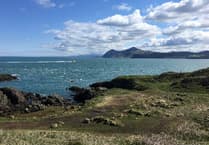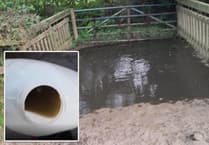Seas and waterways in Gwynedd and Ceredigion saw some of the highest numbers of sewage discharges in England and Wales last year, data suggests.
Figures from water provider Dŵr Cymru (Welsh Water) and regulator Natural Resource Wales (NRW) show Gwynedd was particularly badly affected.
Analysis by website Top of the Poops estimates the constituency of Dwyfor Meirionnydd, covering the majority of the county, saw the second highest number (6,952) of sewage overflows in England and Wales during 2021.
The website claims these equate to nearly 70,000 hours of untreated effluent being spewed into the area’s rivers and seas – equivalent to just over eight years.
In neighbouring Ceredigion, the analysis suggests there were just over 4,000 discharges totalling more than 40,200 hours of sewage being released – the ninth longest duration in England and Wales last year.
It also shows there were a further 3,700 dumps for nearly 30,000 hours in total in the constituency of Arfon in the northern most area of Gwynedd county – which put the area in the top 20 longest periods of overflow.
The website features a breakdown of the estimated frequencies of discharges in particular rivers and coastlines in both Ceredigion and Gwynedd.
This includes the Teifi which, data suggests, saw the longest total duration of discharges of any river in Wales last year.
Controversy surrounds the practices of the UK’s private water companies which are legally entitled to release sewage to relieve pressure on the system during periods of extreme weather.
The private water sector refers to such discharges — which are only permitted in exceptional circumstances — as combined storm overflows (CSOs), and warns of flooding and damage to the system if they are prevented.
Rates of storm overflows across all the nation’s providers are slightly down on last year but rose significantly the year before.
NRW – which regulates water companies Dŵr Cymru and Hafren Dyfrdwy – described Top of the Poops’ analysis as ‘alarming.’
A spokesperson also told us there had been a ‘disappointing’ decline in the performance of Welsh water firms.
Not-for-profit company Dŵr Cymru is responsible for services to around three million people.
It does not deny the accuracy of Top of the Poops’ figures but says it has not yet verified the analysis despite it being in the public domain, and reported on by national newspapers, for more than a year.
The website includes a clear disclaimer that the interpretation of the data provided for Wales was less straightforward than for English companies, so there is greater room for error. They say the data is not broken down at local authority level which makes interpretation of the data more difficult.
The website producers confirmed to the Cambrian News following questioning that no correction had ever been requested from Dŵr Cymru.
A website spokesperson commented: “Deny, Deceive, Delay. Lifted from the handbook of climate science denial.
“We don’t claim that the data is 100 per cent accurate — we do try to make it as accurate as we can.
“On the website, we clearly encourage anybody with concerns as to the accuracy of the data to contact us.
“We have received no request for data correction from any water company — despite the open invitation, and the ease with which it is possible to make such a request.
“In my professional opinion the data is presented from the environmental agencies in such a poor and inconsistent form, that it may be done purely to frustrate data analysis.”
The firm’s own figures, as reported by national media, show there were more than 94,000 reported sewage spills into Welsh waterways in 2021, with sewage being pumped for a total of 785,000 hours.
NRW’s annual performance report, released in June, revealed that 83 sewage-related pollution incidents were caused by Dŵr Cymru last year, compared to 77 the previous year.
Two of these pollution incidents were categorised as having a serious environmental impact.
NRW’s head of operations for Water Quality Sian Williams said: “We want all water companies to meet the expectations of their customers and the needs of our environment, and we are committed to challenging water companies to improve their performance, to ensure overflows are properly controlled, and to take strong and appropriate enforcement action where necessary.
“As a key member of the Wales Better River Quality taskforce we have outlined a plan of action to reduce the impact of storm discharges on our rivers and are overseeing a programme of investment by the water companies.”
A spokesperson added: “Due to an increase in pollution incidents, a decrease in the self-reporting of incidents and a decrease in compliance with environmental permits for sewage discharges, we have downgraded Dŵr Cymru from a four star (industry leading) to a three star (good company) under 2021 Environmental Performance Assessment metrics (EPA).”
Here’s what Welsh Water had to say...
“In the short time provided to respond to this article, it has not been possible to validate the spill numbers quoted by Top of the Poops. We submit our spill numbers annually to our regulator NRW and these are always available to view on our website by anyone at any time.
“It is important to be clear from the outset that the higher spills numbers from our Combined Storm Overflows (CSOs) does not mean that Welsh Water is a poor performer in this area and the numbers must be viewed in the context of two key facts.
“Firstly, Welsh Water is committed to protecting bathing and river water quality and has invested over £8 million on installing monitors on its CSOs to record spill numbers. The company now has monitors on 99.5 per cent of its CSOs which exceeds the coverage of other water companies. This means that Welsh Water has much more data to report on its CSOs to its regulators and so it’s unsurprising that it records larger numbers of spills than others.
“Secondly, due to its geographical location on the British Isles, Wales naturally receives more rainfall than other parts of the UK. As CSOs are designed to operate during heavy rainfall to help protect communities from flooding, our CSOs operate more frequently. Snowdonia National Park for example is amongst the wettest places in the UK and to bring this to life, in February 2020, Capel Curig saw 224mm of rain for the month compared to the UK average of just 97mm of rain. Currently the average spill number for Welsh CSOs is around 33 times per year. If we had the rainfall of Cambridge for instance, the average spill number would be 13 times per year. Their operation is a function of the rainfall we receive in Wales.
“We recognise however that with environmental legislation tightening and customer expectations changing, more needs to be done. Removing CSOs from our system is not an option but what is in our control is the ability to target investment to CSOs which have the biggest impact so that we can improve their performance. That is why we are investing £936 million to 2025 on further improvements to our network.
“Welsh Water has always taken its responsibility for operating CSOs responsibly and invested more than £1 billion as testament to this over the years. This has delivered real improvements and helped ensure that Wales has over a third of the UKs Blue Flag beaches while only having 15 per cent of the coastline.”
Have you found water in your area to be unexpectedly dirty? Send your videos and photos to [email protected]








Comments
This article has no comments yet. Be the first to leave a comment.